As is often the case, this research started with an anecdote which, one thing leading to another, led to a little development on a theme far removed from the initial story. I discovered this biography in 2008 before embarking on my research in 2010. Since then, time has allowed me to consult the JMO, the officers’ file and many documents that have now been digitised.
I started with a detail from the biography of a captain in the colonial artillery, whose full obituary can be found in the Livre d’or des Saboliens tombés au champ d’honneur pendant la guerre 14-18: it says ‘The army corps gave its name to a trench bordering “La Maisonnette” where a lot of fighting took place’. This is an opportunity to work on the memory of this officer and ‘his’ trench.
- Captain Robert Armand Verrier

Robert Verrier was born in Vibraye in the Sarth region of France on 28 February 1880. With his higher education certificate, he joined the 35th RAC in Vannes at the age of 18. He joined the regiment on 18 February 1898, and was promoted to brigadier on 17 September 1898 and maréchal des logis on 13 November 1899. In 1901, he re-enlisted, but with the 1st RAC, becoming a simple driver gunner in the process. He was posted to Sudan from 1902 to 1904 and once again rose through the ranks to become a non-commissioned officer cadet at Versailles in 1906, where he had been training since 1905. Finishing 7th out of 20, he was rated as a very good cavalryman, ‘very suitable for colonial service’, but his involvement varied according to his interests.
Second lieutenant in the 3rd Colonial Artillery Regiment on 1 April 1907, he became lieutenant on 1 April 1909.
After receiving permission from the army, he married Marie Antoinette Adrienne Rey on 26 August 1909 in Saint-Tropez. Barely a month later, he arrived in Madagascar. Their first child, André Gustave, was born on 14 May 1911 in Saharamy, in the Diégo-Suarez province of Madagascar.
Robert Verrier was noted as having a ‘concentrated and susceptible character, difficult to win over. Carries out the internal service of the battery correctly but without enthusiasm, supervising the 3 sections. Has set up the cooperative very well and is interested in it. A little cold in appearance, although with a friendly manner. Slow in applying the firing regulations, in which he initially sought too many details. These notes paint the picture of a young officer who needs to gain experience, after having been an exemplary non-commissioned officer with very few punishments and glowing reports. In fact, from 1904 onwards, the only punishment recorded in his file was ‘none’.
On his return to France in March 1912, a second child, Jean Georges Pierre, was born in Lorient on 23 December 1913. He was then assigned to the 2nd company of workers, after having commanded the 8th battery on foot in the absence of the unit’s officers. The quality of his work is once again highlighted in the notes in his officer’s file.
In 1914, he was posted to the 3rd RA Coloniale in Toulon and commanded the 6th battery. He took an active part in the fighting at Temoigne in Belgium on 23rd August, then at Fère-Champenoise on 8th September.
In February 1915, he was appointed temporary captain and on 9th April 1915 took command of the 4th battery of the 1st Colonial Army Regiment, to which he had just been posted. This unit belonged to the 1st Colonial Army Corps. Robert Verrier had already received a commendation in the regimental order and was mentioned in the army order on 21st October 1915. On 26 October, he was awarded the Legion of Honour.
His superior’s comments were complimentary. He wrote this note on 6 March 1915: ‘Remarkable captain, of absolute bravery and selflessness. Calm, level-headed, active and modest, Captain Verrier is an officer of exceptional merit (emphasis added). After the attacks of 5th September [1914], moved his battery to an advanced position (underlined), where he held it for several weeks under heavy bombardment from the enemy. During this period caused heavy losses to the enemy, owing to the short distance separating his battery from the German lines; remained during this time, day and night, in his observatory situated in our advanced trench.
On 4 April 1916, he was made a permanent captain. The 1st Colonial Army Corps was in the Somme from July 1916. He played an active part in the advance towards Péronne throughout the month.
- Somme, 30th July 1916
On 30 July, Captain Verrier was called to group headquarters. Group commander Jacquin had called a meeting of his three battery commanders. At around 8.15 am, while the meeting was in progress, a single shell fell in the dugout. Major Bour of the 3rd battery was killed instantly, as was Captain Verrier. The group commander, a lieutenant and a second lieutenant were wounded. The two killed were buried, transported to the echelon and buried the next day at Cappy, along with the group commander, who died shortly afterwards. Colonel Franceries, commander of the Colonial Corps divisional artillery, was present, as was Major Lotte. Robert Verrier received a final commendation from the army.
To find out more about Captain Verrier’s life, his biographical note in the Livre d’or des Saboliens tombés au champ d’honneur pendant la guerre 14-18 (Golden Book of Sabolians Fallen in Flanders Fields during the First World War) provides a wealth of additional information, thanks to letters and exchanges between the author and his family. Rather than adding them to the factual information provided, the reader is invited to discover these elements in the transcription of the notice.
CLIQUER ICI (Biography in French).
- Remembering the captain
His memory did not disappear, however. This officer is buried in Sablé-sur-Sarthe, where he lived and where his father was police commissioner. His body was exhumed in June 1922.
His memory is kept alive in the family by his widow and his three sons, André, Jean and Robert. Three sons, because a posthumous child was born on 1 September 1916, barely a month after the death of his father, whose first name he also inherited, Robert Pierre.
The memory of this man is also perpetuated by the affixing of his name to the Sablé-sur-Sarthe war memorial, as well as in a long article in the Livre d’or des Saboliens tombés au champ d’honneur, first published as a serial in the local press. It was a sentence in the latter that drew my attention to a final form of tribute: ‘The CA gave its name to a trench bordering “la Maisonnette” where a great deal of fighting took place’.
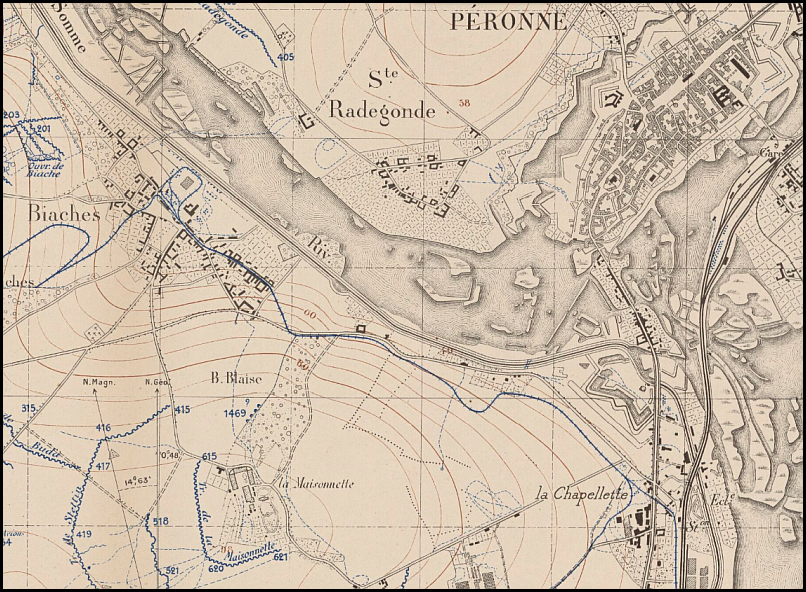
https://gallica.bnf.fr/ark:/12148/btv1b53067336j
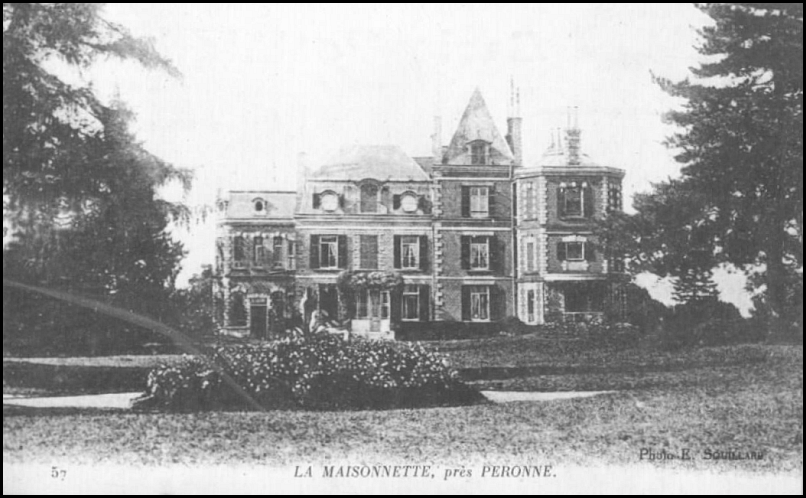
Source : Archives départementales de la Somme, 8 FI 1775
https://archives.somme.fr/ark:/58483/vf3gt40jlsm1/08d31ee8-0ea5-49e0-b6fe-c45fdd20c116
- In search of the ‘Verrier’ trench
In July 1916, ‘La Maisonnette’ was a sector recently conquered by the 1st Colonial Army Corps, although the locality itself remained in German hands for longer.
The map below shows that the 1st C.A.C. made a significant advance, arriving at Biaches, a suburb of Péronne.
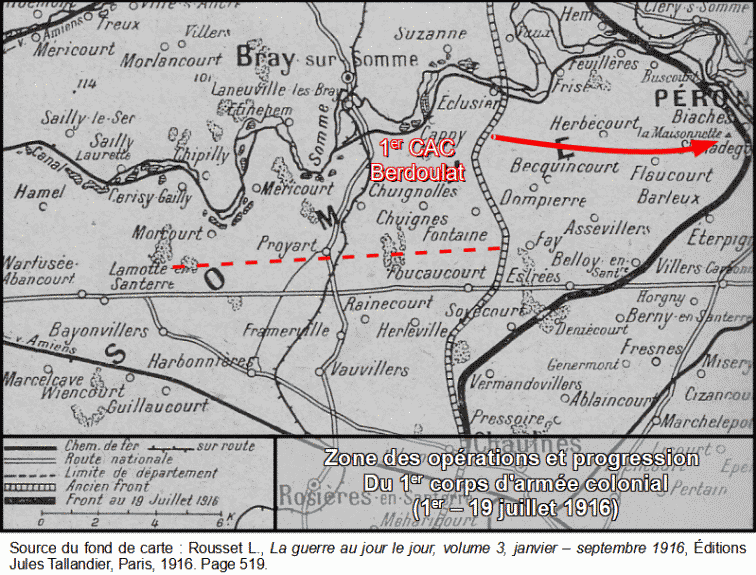
The conquest of this vast sector was accompanied by its reorganisation: new trenches and gutters were dug, some old German lines were abandoned and a place name was established. The name was quickly decided and passed on in an unknown way. In fact, a map dated 14 August 1916 mentions the ‘Verrier’ trench. So far, I have not found any earlier map of the area showing this trench, even under a different name.

Source : Archives départementales de la Somme, 22 FI 80.
https://archives.somme.fr/ark:/58483/9p4x8q3nbzw7/245d8447-5fb1-4a6a-9564-278d9ab3a839
On the other hand, we note the extent to which the officers of the 1st C.A.C. killed during the fighting in July were used as names for new trenches in the sector or for renaming newly conquered trenches. Although the majority of these names are infantrymen, they also include an air force observer, a doctor and our artilleryman. The latest date of death is 4 August 1916. The choice of names was therefore made between this date and the 14th, the date these names were first mentioned on a printed map. Before the attack on 1 July 1916, the names of the German lines were often linked to Germany and the imagination that went with it (‘Kromprinz’, ‘Choucroute’, ‘Saucisses’, ‘Munster’, ‘Stettin’…), so the change in choice is very clear.
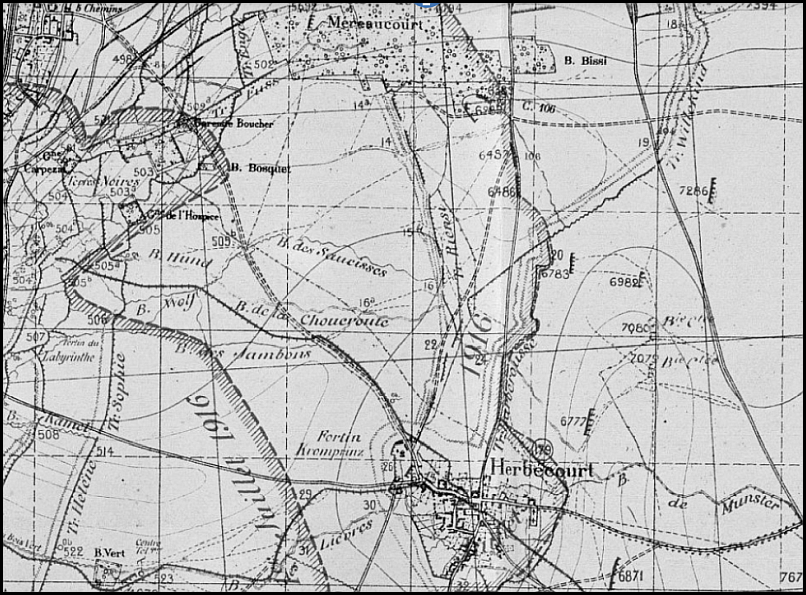
Source : JMO de l’artillerie divisionnaire de la 16e DIC, SHD GR 26 N 477/1, vue 86/130.
With the exception of a few names linked to the local geography (places, woods) or to ancient references (East of Maisonnette, on the banks of the Somme), most of the names belong to officers of the 2nd DIC, the unit that advanced into this area, with the 16th DIC supporting it to the north, at Biaches, and the 3rd DIC to the south.
Cliquer sur l’image pour voir en haute résolution.
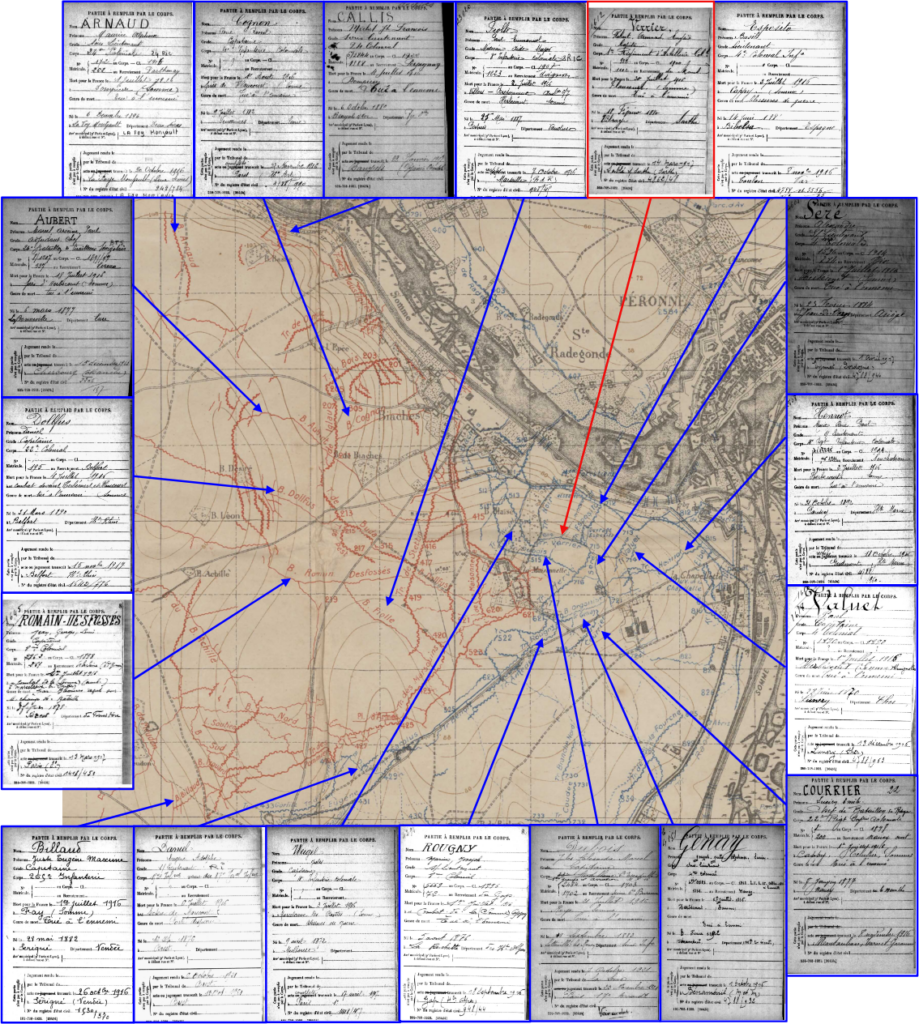
So there was indeed a ‘Verrier’ trench near ‘La Maisonnette’. Was this trench name permanent?
- A name that remains
From August 1916 onwards, Verrier Trench appeared on all available maps until December 1916, as long as the sector was held by French troops. The area, although still active as this sketch of an attack from 18 to 21 October 1916 shows, changed little and the ‘Verrier’ trench remained.

The loss of the salient formed by the fortified point of ‘La Maisonnette’ on 29 October 1916 was the only notable event. The Verrier trench moved away from the French lines.
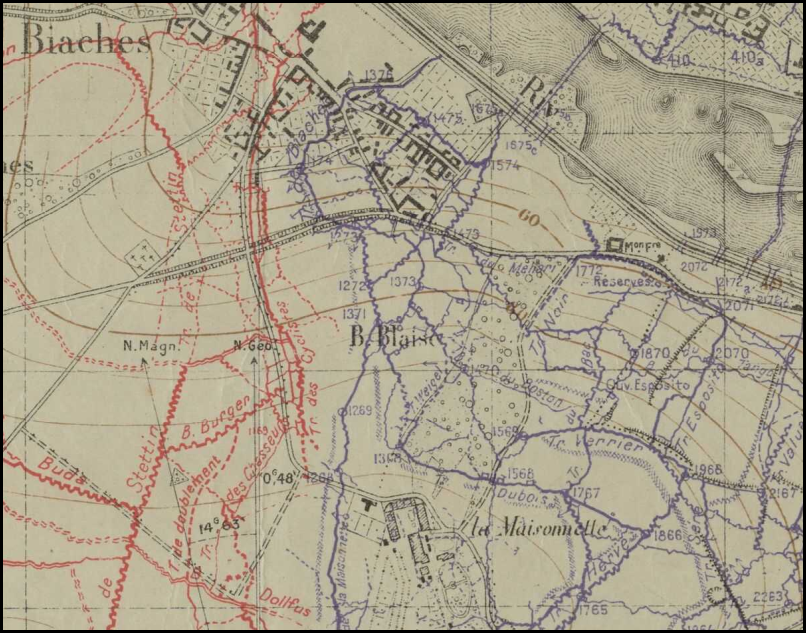
Source : Archives départementales de la Somme, 22 FI 43.
https://archives.somme.fr/ark:/58483/wcsd38tj4107/3f217152-bc17-4a22-9128-2bf54e841d4c
- The « Verrier Trench »

Source : Archives départementales de la Somme, 22 FI 43.
https://archives.somme.fr/ark:/58483/wcsd38tj4107/3f217152-bc17-4a22-9128-2bf54e841d4c
This British map from January 1917 does indeed mention the ‘Verrier Trench’. In fact, the entire toponymy has been retained, with the addition of a ‘Boston Trench’ to indicate a new structure. A map dated 22 February 1917 gives a good picture of the area, with several abandoned trenches around the Verrier Trench..

The German withdrawal in March 1917 liberated this part of the country. Did the family go there at this time?
Recaptured by the Germans in March 1918, the sector was not abandoned until 1 September 1918. The last sighting of the Verrier Trench on a map was not in August 1918, as the legend indicates, but on a trench line in March 1918, as shown below (the dates on the English maps consulted are written in the ‘French’ style, i.e. ‘J-M-A’).

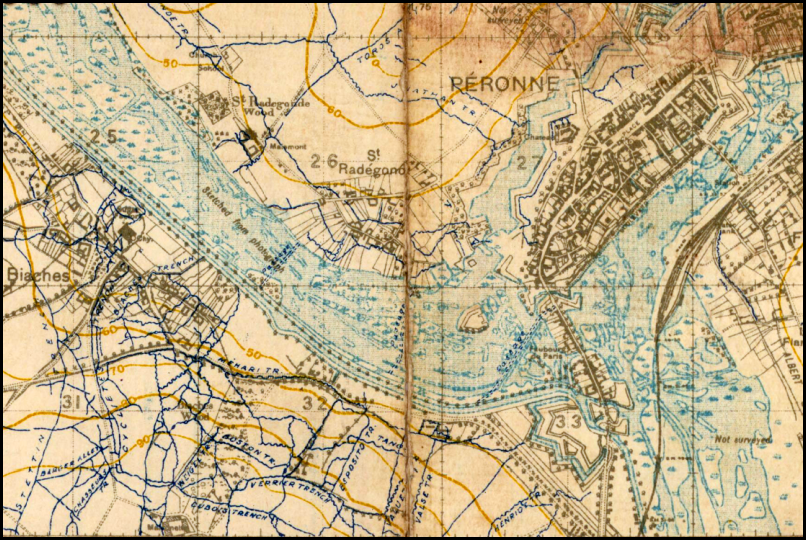
However, the great similarity with the January 1917 map raises questions about the reality of the proposed routes. It seems surprising that, after the events of 1917-1918, all the gutters and trenches were maintained.
- Conclusion
After so much fighting, the area was totally devastated. The map of the areas destroyed on 1 December 1920 shows the known areas around ‘La Maisonnette’. The legend does not specify the state of the land around the inhabited areas and woods destroyed by the fighting.
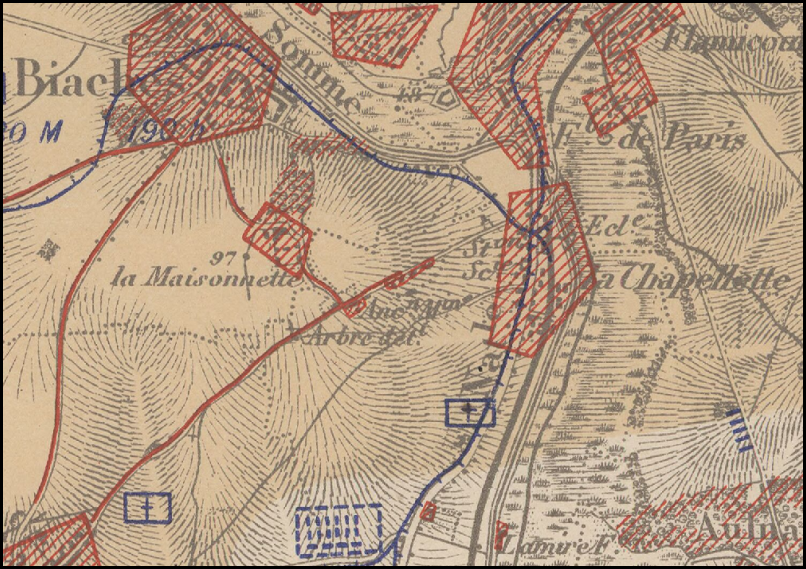
Surprisingly, the area was quickly cleared and recultivated. So much so that the traces of the war, seen from the air twenty years later in 1939, have all but disappeared. ‘La Maisonnette’ had been rebuilt, the fields recultivated and the nearby wood replanted. There are no longer any traces of the various trenches that lined the left bank of the Somme; no more ‘Verrier Trench’.
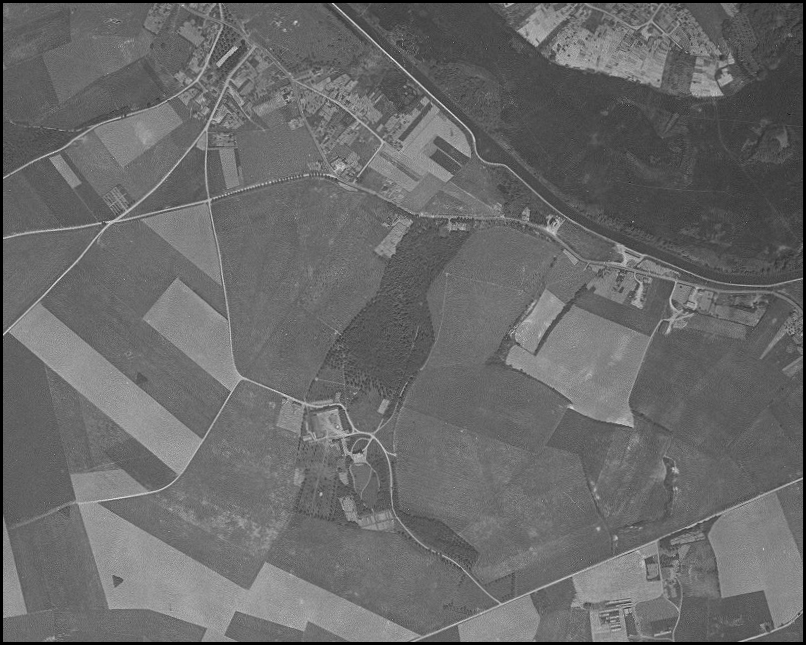
Identifiant de la mission : C2508-0031_1939_F2508_0040, 5 juin 1939.
Did the family make a pilgrimage to the site after the war? What place was given to this man’s disappearance over the decades? Perhaps, a century later, a few family mementos and a plaque on a grave still preserve the memory of this life? For sure, we can find traces of this man in the first name of a posthumous child, in a hagiography in a visitors’ book and on a tombstone in the cemetery of Sablé-sur-Sarthe.
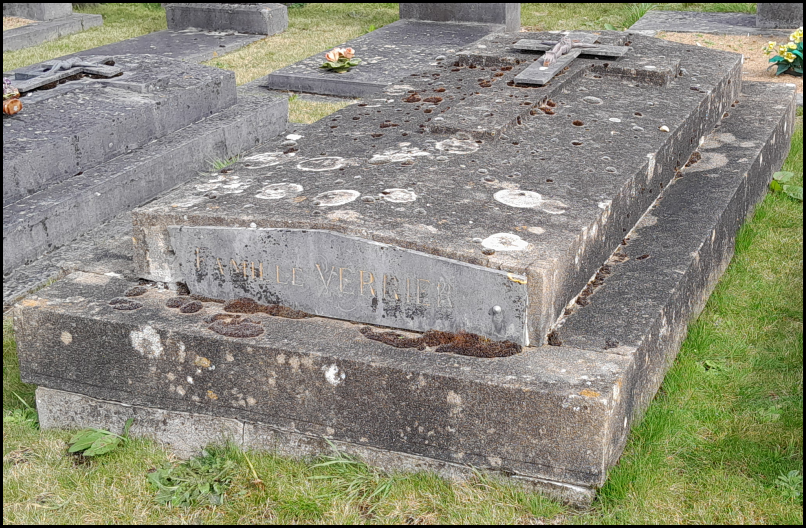
And for those who can see it, his name appears on a handful of maps as the name of a trench.
And the text that told you the story of the name of this trench and the man who inspired it.
- We’re looking for :
If you have aerial photographs of the area between 1916 and 1918, they would help us to get a better look at this trench. The same applies if you have any additional information about Robert Verrier.
Please do not hesitate to contact the author.
- Pour en savoir plus :
Découvrez la transcription de la biographie du capitaine Verrier publiée après-guerre à Sablé-sur-Sarthe :
https://parcours-combattant14-18.fr/biographie-du-capitaine-verrier-1880-1916-1er-ca-colonial
- Sources :
BELIN (E) : Livre d’or des Saboliens tombés au champ d’honneur pendant la guerre 1914-1918, Imprimerie-Librairie E. Coconnier, Sablé-sur-Sarthe, 1921, pp. 16 à 28.
Site Mémoire des Hommes
Archives nationale :
Dossier de la Légion d’honneur : LH/2696/30
Service Historique de la Défense :
– SHD GR4 YE 1612 – Dossier d’officier de Robert Armand VERRIER
– SHD GR 26 N 1227/3 : 2e groupe du 1er Régiment d’artillerie coloniale
– SHD GR 26 N 1227/5 : 4e batterie du 1er Régiment d’artillerie coloniale
– SHD GR 26 N 1227/7 : 3e batterie du 1er régiment d’artillerie coloniale (erreur dans le site : indiquée comme 4e batterie)
– SHD GR 26 N 832/8 : JMO du 60e BCP.
IGN : remonter le temps
Identifiant de la mission : C2508-0031_1939_F2508_0040 ; Date de prise de vue : 05/06/1939.
Cartes :
Péronne. Groupe des canevas de tir, 6 juillet 1916.
BNF, GE BB-366 (21).
https://gallica.bnf.fr/ark:/12148/btv1b53067336j
Sud de la Somme. Groupe des canevas de tir, 14 août 1916.
Archives départementales de la Somme, 22 FI 80.
https://archives.somme.fr/ark:/58483/9p4x8q3nbzw7/245d8447-5fb1-4a6a-9564-278d9ab3a839
Péronne. Groupe des canevas de tir, 5 décembre 1916.
Archives départementales de la Somme, 22 FI 43.
https://archives.somme.fr/ark:/58483/wcsd38tj4107/3f217152-bc17-4a22-9128-2bf54e841d4c
Péronne. Groupe des canevas de tir, 20 mai 1918.
Archives départementales de la Somme, 22 FI 67.
https://archives.somme.fr/ark:/58483/km3qb06tpr4s/53c54632-5cd7-4f71-8552-d2976537f9c5
Carte spéciale des régions dévastées. 13 SO, Cambrai [Sud-Ouest], Service géographique de l’armée, 1920.
BNF, GE CC-698 (13 SO-1920-2).
https://gallica.bnf.fr/ark:/12148/btv1b8593481j
Site canadien de fonds de carte. Possibilité de les consulter avec un outil sur le site mais aussi de les télécharger en très haute définition. Classement remarquable et accès géographique.
http://digitalarchive.mcmaster.ca/
Carte du secteur avant l’offensive avec mention des avancées française du 1er au 8 juillet
SHD 26 N 477/1 : JMO de l’artillerie de la 16e DIC
